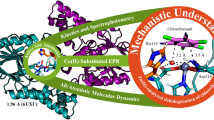Abstract
Chemiosmotic coupling mechanisms operate in the electron transfer reactions from: nitrite to O2, NO2 − to NAD+, ascorbate to O2, NADH to O2, and NADH to NO3 −. The enzyme systems catalyzing these reactions are named NO2 −:O2 oxidoreductase, ATP-dependent NO2 −:NAD+ oxidoreductase, ascorbate:O2 oxidoreductase, NADH:O2 oxidoreductase, and NADH:NO3 − oxidoreductase, respectively. All of the oxidoreduction reactions are exergonic with the exception of the ATP-dependent NO2 −:NAD+ oxidoreductase system, which involves reversed electron flow against the thermodynamic gradients. The mechanism for nitrite oxidation was found to be quite different from that of ascorbate oxidation; both systems were insensitive, however, to rotenone, amytal, antimycin A, and 2-n-heptyl 4-hydroxyquinolineN-oxide. These compounds, on the other hand, severely inhibited the electron transfer reactions catalyzed by NADH:O2 oxidoreductase, NADH:NO3 − oxidoreductase, and the ATP-dependent NO2 −:NAD+ oxidoreductase, indicating a common pathway of electron transport in these oxidoreductase systems. Cyanide inhibited all systems except the NADH:NO3 − oxidoredctase. The uncoupler carbonyl cyanide-m-chlorophenyl hydrazone strongly inhibited NO2 −:O2 oxidoreductase and ATP-dependent NO2 −:NAD+ oxidoreductase, which indicates the involvement of energy-linked reactions in both systems; the uncoupler caused a marked stimulation of the NADH:O2 oxidoreductase and NADH:NO3 − oxidoreductase without affecting the ascorbate:O2 oxidoreductase activities.
Similar content being viewed by others
Literature Cited
Aleem, M. I. H. 1965. Path of carbon and assimilatory power in chemosynthetic bacteria. I.Nitrobacter agilis. Biochemica et Biophysica Acta107:14–28.
Aleem, M. I. H. 1967. Energy conversions in the chemoautotrophNitrobacter agilis. Bacteriological Proceedings67:112.
Aleem, M. I. H. 1968. Mechanism of oxidative phosphorylation in chemoautotrophNitrobacter agilis. Biochimica et Biophysica Acta162:338–347.
Aleem, M. I. H., Hoch, G. E., Varner, J. E. 1965. Water as the source of oxidizing and reducing power in bacterial chemosynthesis. Proceedings of the National Academy of Sciences of the United States of America54:869–873.
Aleem, M. I. H., Lees, H., Nicholas, D. J. D. 1963. Adenosine triphosphate-dependent reduction of nicotinamide adenine dinucleotide by ferro-cytochromec in chemoautotrophic bacteria. Nature200:759–776.
Aleem, M. I. H., Nason, A. 1959. Nitrite oxidase, a particulate cytochrome electron transport system fromNitrobacter. Biochemical and Biophysical Research Communications1:323–327.
Aleem, M. I. H., Nason, A. 1960. Phosphorylation coupled to nitrite oxidation by particles from the chemoautotrophNitrobacter agilis. Proceedings of the National Academy of Sciences of the United States of America46:763–769.
Butt, W. D., Lees, H. 1958. Cytochromes ofNitrobacter. Nature182:732–733.
Cobley, J. G. 1973. The enigma of energy conservation inNitrobacter. Ph.D. thesis, University of Bristol, England.
Cobley, J. G. 1976. Reduction of cytochromes in electron transport particles fromNitrobacter winogradskyi. Biochemical Journal156:493–499.
Haddock, B. A., Jones, C. W. 1977. Bacterial respiration. Bacteriological Reviews41:47–99.
Ingledew, W. J., Cobley, J. G., Chappell, J. B. 1974. Cytochromes of theNitrobacter respiratory chain. Biochemical Society Transactions2:149–151.
John, P., Whatley, F. R. 1977. The bioenergetics ofParacoccus denitrificans. Biochemica et Biophysica Acta463; 129–153.
Kiesow, L. 1964. On the assimilation of energy from inorganic source in autotrophic forms of life. Proceedings of the National Academy of Sciences of the United States of America52:980–988.
Kiesow, L. 1967. Energy-linked reactions in chemoautotrophic organisms. Current Topics in Bioenergetics2:195–233.
Latimer, W. M. 1952. Oxidation potentials, 2nd ed., p. 393. New York: Prentice-Hall.
Lees, H., Simpson, J. R. 1957. The biochemistry of nitrifying organisms. 5. Nitrite oxidation byNitrobacter. Biochemical Journal65:297–305.
Sewell, D. L., Aleem, M. I. H. 1969. Generation of reducing power in chemosynthesis. V. The mechanism of pyridine nucleotide reduction in the chemoautotrophNitrobacter agilis. Biochimica et Biophysica Acta172:467–475.
Sewell, D. L., Allem, M. I. H. 1979. NADH-linked oxidative phosphorylation inNitrobacter agilis. Current Microbiology2:35–37.
Sewell, D. L., Aleem, M. I. H., Wilson, D. F. 1972. The oxidation-reduction potentials and rates of oxidation of the cytochromes ofNitrobacter agilis. Archives of Biochemistry and Biophysics153:312–319.
Author information
Authors and Affiliations
Rights and permissions
About this article
Cite this article
Hussain Allem, M.I., Sewell, D.L. Mechanism of nitrite oxidation and oxidoreductase systems inNitrobacter agilis . Current Microbiology 5, 267–272 (1981). https://doi.org/10.1007/BF01567916
Issue Date:
DOI: https://doi.org/10.1007/BF01567916




